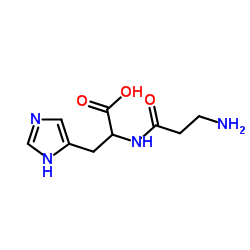Phosphoglycerate kinase

Phosphoglycerate kinase structure
|
Common Name | Phosphoglycerate kinase | ||
|---|---|---|---|---|
| CAS Number | 9001-83-6 | Molecular Weight | 226.232 | |
| Density | 1.4±0.1 g/cm3 | Boiling Point | 656.2±55.0 °C at 760 mmHg | |
| Molecular Formula | C9H14N4O3 | Melting Point | N/A | |
| MSDS | Chinese USA | Flash Point | 350.7±31.5 °C | |
Use of Phosphoglycerate kinasePhosphoglycerate kinase (PGK), namely phosphoglycerate kinase, is a glycolytic enzyme commonly used in biochemical research. Phosphoglycerate kinase can catalyze the reversible transfer of phosphate groups from 1,3-bisphosphoglycerate (1,3-BPG) to ADP to generate 3-phosphoglycerate (3-PG) and ATP. At the same time, it can also participate in gluconeogenesis, catalyzing the opposite reaction to produce 1,3BPGA and ADP. Phosphoglycerate kinase is involved in energy metabolism, interaction with nucleic acid, tumor progression, cell death and virus replication and other related processes[1]. |
| Name | Kinase(Phosphorylating), Phosphoglycerate |
|---|---|
| Synonym | More Synonyms |
| Description | Phosphoglycerate kinase (PGK), namely phosphoglycerate kinase, is a glycolytic enzyme commonly used in biochemical research. Phosphoglycerate kinase can catalyze the reversible transfer of phosphate groups from 1,3-bisphosphoglycerate (1,3-BPG) to ADP to generate 3-phosphoglycerate (3-PG) and ATP. At the same time, it can also participate in gluconeogenesis, catalyzing the opposite reaction to produce 1,3BPGA and ADP. Phosphoglycerate kinase is involved in energy metabolism, interaction with nucleic acid, tumor progression, cell death and virus replication and other related processes[1]. |
|---|---|
| Related Catalog | |
| References |
| Density | 1.4±0.1 g/cm3 |
|---|---|
| Boiling Point | 656.2±55.0 °C at 760 mmHg |
| Molecular Formula | C9H14N4O3 |
| Molecular Weight | 226.232 |
| Flash Point | 350.7±31.5 °C |
| Exact Mass | 226.106583 |
| LogP | -2.17 |
| Vapour Pressure | 0.0±2.1 mmHg at 25°C |
| Index of Refraction | 1.591 |
| Storage condition | 2-8°C |
| Personal Protective Equipment | Eyeshields;Gloves;type N95 (US);type P1 (EN143) respirator filter |
|---|---|
| Hazard Codes | Xi |
| RIDADR | NONH for all modes of transport |
|
Quantitative phosphoproteomic analysis of T cell receptor signaling reveals system-wide modulation of protein-protein interactions.
Sci. Signal. 2 , ra46, (2009) Protein phosphorylation events during T cell receptor (TCR) signaling control the formation of complexes among proteins proximal to the TCR, the activation of kinase cascades, and the activation of tr... |
|
|
Initial characterization of the human central proteome.
BMC Syst. Biol. 5 , 17, (2011) On the basis of large proteomics datasets measured from seven human cell lines we consider their intersection as an approximation of the human central proteome, which is the set of proteins ubiquitous... |
|
|
The first identification of lysine malonylation substrates and its regulatory enzyme.
Mol. Cell. Proteomics 10(12) , M111.012658, (2011) Protein post-translational modifications (PTMs) at the lysine residue, such as lysine methylation, acetylation, and ubiquitination, are diverse, abundant, and dynamic. They play a key role in the regu... |
| 2-[(3-Aminopropanoyl)amino]-3-(1H-imidazol-4-yl)propanoic acid |
| Histidine, β-alanyl- |
| MFCD00130301 |
| 3-PHOSPHOGLYCERIC PHOSPHOKINASE |
| N-(3-Aminopropanoyl)histidine |
| ATP: 3-PHOSPHO-D-GLYCERATE 1-PHOSPHOTRANSFERASE |
| 3-PHOSPHOGLYCERIC PHOSPHOKINASE*FROM RAB BIT MUSCLE |
| EINECS 232-636-1 |
| EC 2.7.2.3 |
| b-Alanylhistidine |
| β-Alanylhistidine |
| carnosine |
| 3-PHOSPHOGLYCERIC PHOSPHOKINASE FROM*BAK ERS YEAST C |
| 3-PHOSPHOGLYCERATE KINASE |
| 3-phosphoglyceric phosphokinase from*bakers yeast |
| Kinase (phosphorylating), phosphoglycerate |

